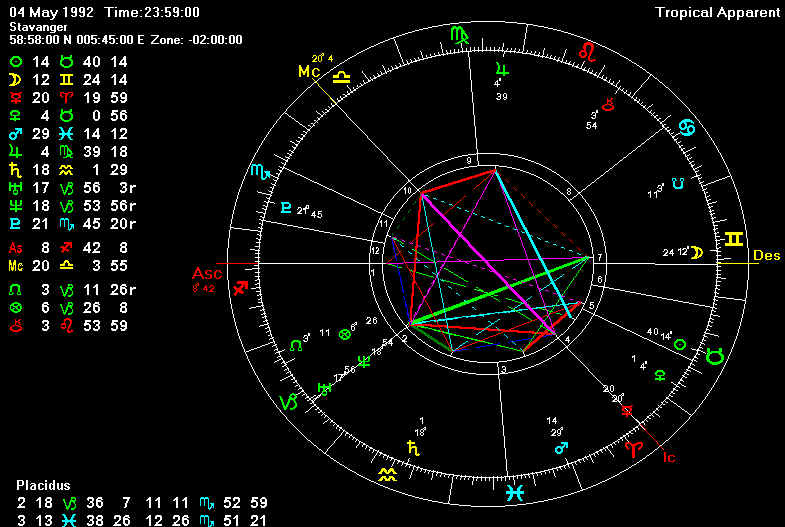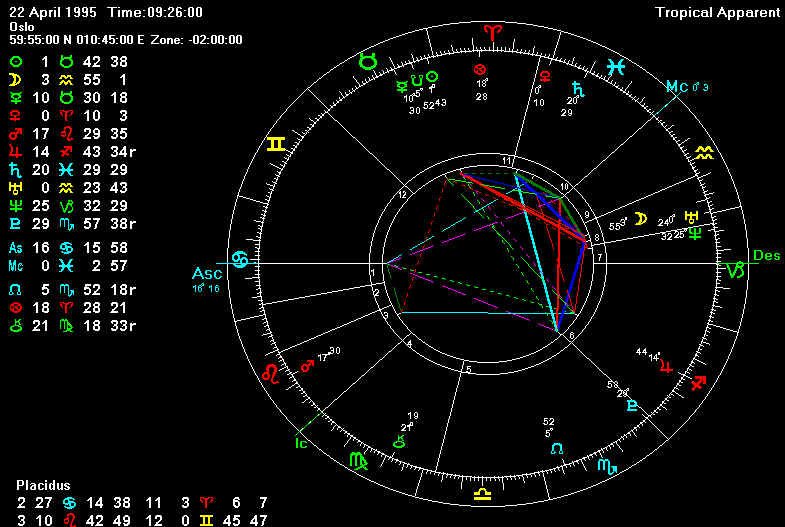| 1)
If the natural sign of the lord of the hour ascends,
viz. hr MO & Asc CN, hr ME
& Asc GE, etc... first pay attention to the design of
the question which could be contradicted or disproved.
Oddly enough, the question may have been asked back to
front. Next, look for some positive affirmation. There is
no peril or damage to the querent, but the chart could
forward protection or loss, according to the nature of
the lord of the hour. This is a fortunate interval
elected for cure, healing, or inducing relief. 2) If the sign of exaltation ascends, i.e. hr JU & Asc CN, hr SA & Asc LI, etc... strength, success, protection and recovery is granted to the querent. It is opportune moment for competition and speculation, however, the lord of the hour should properly rule those affairs for success to be ensured. 3) If the sign of the planets triplicity ascends, i.e. hr MA & As CN, etc... then affairs proceed according to a correct order. The person is not guilty of the crime he is accused. The monetary affairs of the querent are taken care of and protection granted his belongings. 4) If the lord of the hour shares the same powers as the ruler of the ascendent, ie. hr SU & Asc SC-MA, hr MO & Asc LI-VE, hr ME & Asc CP-SA, etc... then business will be performed according to the powers of the ruler of the hour. Viz. SA will promote real-estate and affairs of old age, otherwise bring illness, denial and delay, etc.. 5) If the lord of the hour shares the same powers as the sign on the ascendant, i.e. hr MO & Asc SC, hr ME & Asc TA, hr JU & Asc AQ, etc... then bear in mind that which is naturally signified by the ruler of the ascendant. 6) If the lord of the hour closely aspects the ascendant, its ruler or the Moon, then the chart is fit to be judged, but consider the nature of the aspect, for this will reflect whatever lies on the path towards concluding the end result indicated by the chart. Viz. An opposition will indicate some inconvenience, mishap or humiliation, although the end result may be perfectly achieved. 7) If the lord of the hour is in the same triplicity as the lord of the ascendant, i.e. hr JU in AR & Asc VI with ME in LE, etc... then the chart is radical and fit to be judged, but the end result is achieved indirectly, through circumstance, some co-operation, alliance, or the assistance of friends. 8) A gathering of several of these conditions is a fortunate testimony. Viz. hr. SU & As SG; The Sun rules both the triplicity by day, shares the same powers as Sagittarius, may appear in the same triplicity as Jupiter, and also be aspecting the ascendant or it's ruler. 9) If the same planet rule both hour and day, then this is a fortitude according to the office of that planet. A relationship between the ruler of the day and the ascendant may offer an assisting hand. 10) Be aware how often Mercury may corrupt the Moon, as when hr ME & Asc CN, hr MO & Asc GE, hr MO & Asc VI, for this will truly bring about unwanted mischief and denies perfection. 11) On the same accord, the disagreement between the lord of the hour and the day ruler disrupts perfection, viz. hr MO & dy ME, hr MO & dy MA, hr ME & dy MO, hr ME & dy JU, etc. The combination of MO & MA often causes infection. SU & SA together is barren. 12) Nothing can be performed without the assistance of the lord of the hour. If there is no relation between the lord of the hour and the sign ascending or its lord, the chart shows something out of tune and not working properly. It is like striking a dumb note on the celestial instrument. The querent may not have had a serious intention of proposing the question. According to the ancient stricture, the astrologer is more liable to plunge himself into difficulties and should examine whether the querent has the correct reasons for asking the question. An irregularity is in existence and the rules are not being followed. There could be a disturbing circumstance and the matter leads to unhappiness or unacceptance.
TWO EXAMPLE CHARTS 1) A chart not radical Of a man who wanted to know whether he would be involved with a certain woman. Time 21.59 GMT, May 4. 1992, 58N58, 5E45.
The chart shows the significator of the woman, Mercury, close the exaltation degree of the Sun and angular in Aries on the cusp of the fourth house. The querent said how attractive (Suns exaltation degree) he found the young woman (Mercury), and that he had met her several times in her place of occupation (her 10th of the turned chart). She worked in the local post office. Saturn, lord of the hour, had no relation to the ascendant or it's lord, so I judged that something of the question was out of tune, not properly grounded and might have an unhappy conclusion. Saturn, by nature, does not promote but rather hinders love affairs. I therefore told the querent that his affections were not likely to be reciprocated. Mars, dispositor of the lord of the seventh, was about to enter his own sign, so something regarding the quesited was about to change or be revealed in the immediate future. The Moon applied to the lord of the hour, Saturn, by a trine through short ascension, revealing something along the nature of a square. However, Venus, lady of the 5th applied by trine to Jupiter, who was lord of the first and significator of the querent. So I comforted the querent, adviced him to direct his attention elsewhere and that he soon may enjoy fortunate circumstances. The querent told me that the following day when he went to the post office, the woman in question was wearing a wedding ring. He had never seen her wear a wedding ring before and this concluded the end of his question. 2) A chart not radical A woman wanted to know whether she was pregnant or not. The question was proposed time 07.26 GMT, April 22. 1995, 59N56, 10E43.
It is the day of Saturn and the hour of the Sun. The lord of the hour has no dignities in the ascendant and has no relation to the lord of that sign, who is the Moon. This could be a warning that the querents hopes will not be met. Although the lord of the hour is in the 11th in reception with lord of the 5th, and the Moon seperates from the lord of the hour by a square through signs of short ascension. The woman desired to have a child. The Moon, who was her significator, was in Aquarius in the 8th house. The 8th signifies sexual activity and matters that dwell in the twilight zone between life and death. Luna last passed over Uranus, who by modernists is allotted a co-rulership in Aquarius, and who indicated a change of pace or rhytmn. Certainly Uranus in this sign did not outrule the possibility of some change in the querents world or sense of existance. The Moons previous aspect is her square to the Sun, who is intercepted in the 11th house. The aspect is cast through signs of short ascension and the Sun is lord of the hour and in reception with Venus, who is ruler of the 5th. I therefore judged that the lady was pregnant, but due to the question being proposed on the day of Saturn and in the hour of the Sun, the feutus had not fastened. The lady proved to be pregnant but the feutus did not fasten and in less than two weeks, when the Moon was directed to the square of the Nodes in Scorpio, she aborted. Andrew J. Bevan, (c) 1996 |

